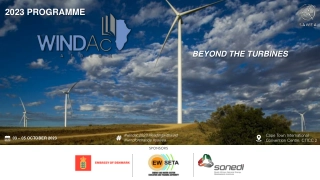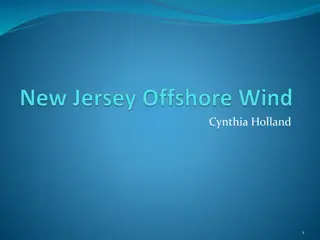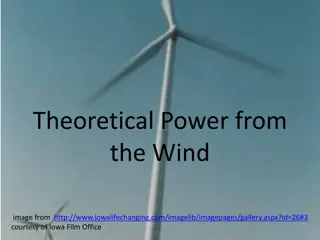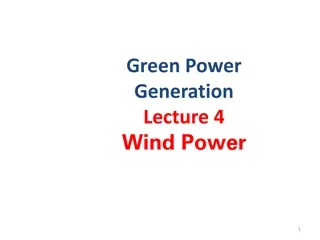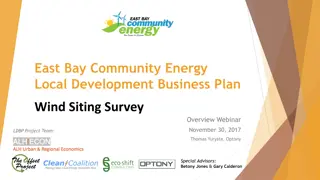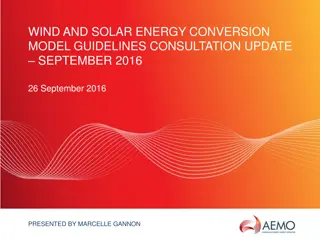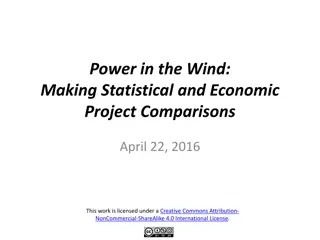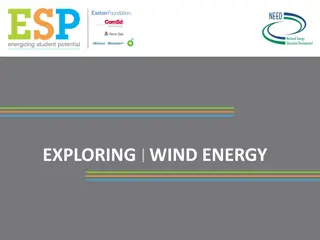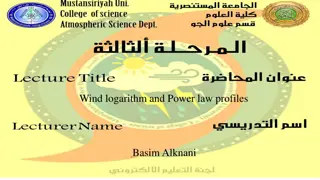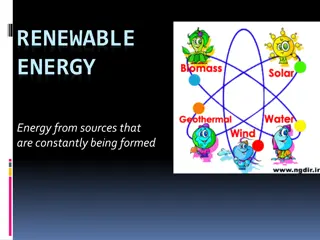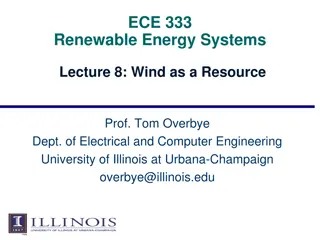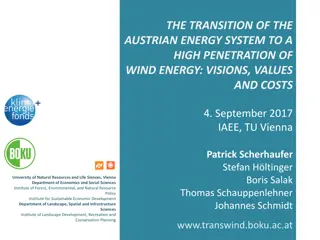Exploration of Wind Energy Finance in Educational Programme
Delve into the realm of wind energy finance through a comprehensive educational programme focusing on recognizing market trends, analyzing annual reports, financial assessment of projects, risk management, and investment decision-making criteria. The programme covers topics such as energy market overview, project financials, business plans, case studies, and assessments, aiming to equip participants with the skills to finance wind energy projects effectively.
Uploaded on Nov 20, 2024 | 0 Views
Download Presentation

Please find below an Image/Link to download the presentation.
The content on the website is provided AS IS for your information and personal use only. It may not be sold, licensed, or shared on other websites without obtaining consent from the author. Download presentation by click this link. If you encounter any issues during the download, it is possible that the publisher has removed the file from their server.
E N D
Presentation Transcript
Finance Lecture # 1 Jan H. Jansen E-mail: jan.jansen@han.nl
Dropbox URL: https://www.dropbox.com/home#:::64295139
Minor Wind Energy Project Management Finance Law Energy Project Supply Chain Management Mechanical Engineering Construction
Minor Wind Energy Project Management Commercial Finance Law Energy Project Supply Chain Management Mechanical Engineering Construction Engineering
Commercial Educational unit: WEPM-C (7.5 ECTS) WEPM-C-LW Law 30% 5.5 WEPM-C-FC Finance 40% 5,5 WEPM-C-SC ISCM 30% 5,5
What is our ambition? Recognizing trends in the Wind Energy market Analyzing an annual report of a wind energy supplier; Constructing an cash flow overview of wind energy project; Establish risk awareness (project- , exchange -, interest rate- and political risks) Decision criteria for an investment in a wind energy project (PBP, ROI, NPV, IRR and BET). Financially sourcing a wind energy project.
Assessment WEPM-C-FC Written exam of 120 minutes (PW8) WEPM-P-FR Finance will also be assed in the final report and presentation of the project of this minor
Programme Lecture Topic 1 Overview Energy Market 2 Annual Reports 3 Project Financials, Value Propositions & Business Model 4 Business plan I 5 Business plan II 6 Case study WEPM 7 Case study WEPM 8 Written Exam
Energy Market Electricity Oil Electricity Gas Electricity Coal Electricity Nuclear Electricity Wind Electricity Hydro Electricity Solar Electricity Biomass Electricity Geothermal
Electricity market Complex market See slide before The art of electricity Not directly tangible Storage problems Capacity Transformation of Wind (free good) into Electricity (economic good)
Overview Energy Market Macro level Energy prices (P) Energy demand (Q) Meso level / Industry level Micro level / Firm level Value chain & supply chain Annual Reports
Macro level Energy prices (P) Prices of substitutes / Trends http://www.bloomberg.com/energy/ http://www.energy.eu/ Energy demand (Q) Trends http://www.nwea.nl/ http://www.ewea.org/
Renewable energy in final energy consumption (2020 target) Source: www.energy.eu 2006 2007 2008 2020 Target % To cover: United Kingdom 1.5 % 1.8 % 2.2 % 15 % 12.8 % France 9.6 % 10.2 % 11 % 23 % 12 % Denmark 16.8 % 18.1 % 18.7 % 30 % 11.3 % Netherlands 2.5 % 3 % 3.2 % 14 % 10.8 % Italy 5.3 % 5.2 % 6.6 % 17 % 10.4 % Belgium 2.7 % 3 % 3.3 % 13 % 9.7 % Spain 9.1 % 9.5 % 10.7 % 20 % 9.3 % Germany 6.9 % 9 % 8.9 % 18 % 9.1 % Austria 24.8 % 26.6 % 28.3 % 34 % 5.7 % Sweden 42.7 % 44.2 % 44.4 % 49 % 4.6 %
Renewable electric energy in the EU Resource: 2005: 2006: 2007: 2008: Hydro energy Wind energy Biomass Geothermal energy Solar energy 60.60 % 20.40 % 17.00 % 64.40 % 17.10 % 16.70 % 60.60 % 20.40 % 17.00 % 60.00 % 21.00 % 17.00 % 1.20 % 1.20 % 1.20 % 1.00 % 0.80 % 0.50 % 0.80 % 1.00 % Resource: www.energy.eu
Meso level / Industry level Wind Energy Farm Distribution Suppliers
Micro level / Firm level Wind Energy Farm Input Procurement > Production > Sales > Throughput > Output
Annual reports Market & Strategy Corporate Governance Corporate Social Responsibility (CSR) Sustainability Financial ratios Profitability Liquidity Solvency Activity
Structure of the balance sheet Equity: Issued Capital Retained earnings / Reserves Long Term Liabilities Provisions Loans Bonds Current liabilities: Creditors / AP Bank overdraft Taxes Dividend Fixed assets: Property, Plant & Equipment Intangible assets Financial noncurrent assets Current assets: Inventories Debtors / AR Cash & Cash equivalents
Structure of the income statement / profit & loss account Costs Costs of Sales: Cost of raw materials Cost of (manufacturing) labour Costs of depreciation of equipment Overhead costs: Selling expenses R&D expenses General expenses Administrative expenses Other expenses Incidentals Financial charges Operating income Revenues / Sales
Profit definitions Gross Profit: Revenues - Cost of Sales Operating Income / EBIT: Gross Profit - Overhead costs EBITDA: EBIT + Depreciation + Amortization EVA: NOPAT - Capital Charges : NOPAT = EBIT - Taxes Capital Charges = Invested Capital * Cost of Capital
Performance of the company: Liquidity The ability of an asset to be converted into cash without a significant price concession Current ratio: Current Assets / Current Liabilities Quick ratio: { Current Assets -/- Inventories } / Current Liabilities
Performance of the company: Solvency Solvency shows how the extent to which the firm is financed by debt Debt Ratio: Debt / Total Assets Debt-To-Equity Ratio: Debt / Shareholder s Equity
Performance of the company: Profitability Compares profit (output) with invested money (input) of the firm Gross Profit Margin: Gross Profit / Sales ROI (ROA) = Return on Investment (Assets) Net Profit after taxes / Total Assets ROE = Return on Equity Net Profit after taxes / Shareholder s Equity
Performance of the company: Economic activity Provides performance information of the efficiency of some internal processes Asset turnover Sales / Assets Inventory turnover Cost of goods sold / Inventory Receivable turnover (collection period) Sales / Receivables
Du Pont formule ROE = NPM * TAT * EM NPM = Net Profit Margin (Market profit) NPM = Net Profit / Sales TAT = Total Assets Turnover (Utilisation) TAT = Sales / Total Assets EM = Equity Multiplier (Financial structure) EM = Total Assets / Total Equity
Altmans Z-score Working Capital / Total Assets * 1.2 Retained Earnings / Total Assets * 1.4 EBIT / Total Assets * 3.3 Market Value Equity / Book Value Liabilities * 0.6 Sales / Total Assets * 0.999
Annual reports (2010) of Sustainable Energy Industry Van Oord (case for the lectures) Teams Eneco Vestas ABB RWE GE Siemens Nordex BP Shell
Organisation # Company URL Team members 0 Van Oord www.vanoord.com Mr Jan Jansen 1 Eneco www.eneco.com 2 Vestas www.vestas.com 3 ABB www.abb.com 4 RWE www.rwe.com 5 GE www.ge.com 6 Siemens www.siemens.com www.nordex- online.com www.bp.com 7 Nordex 8 BP 9 Shell www.shell.com


